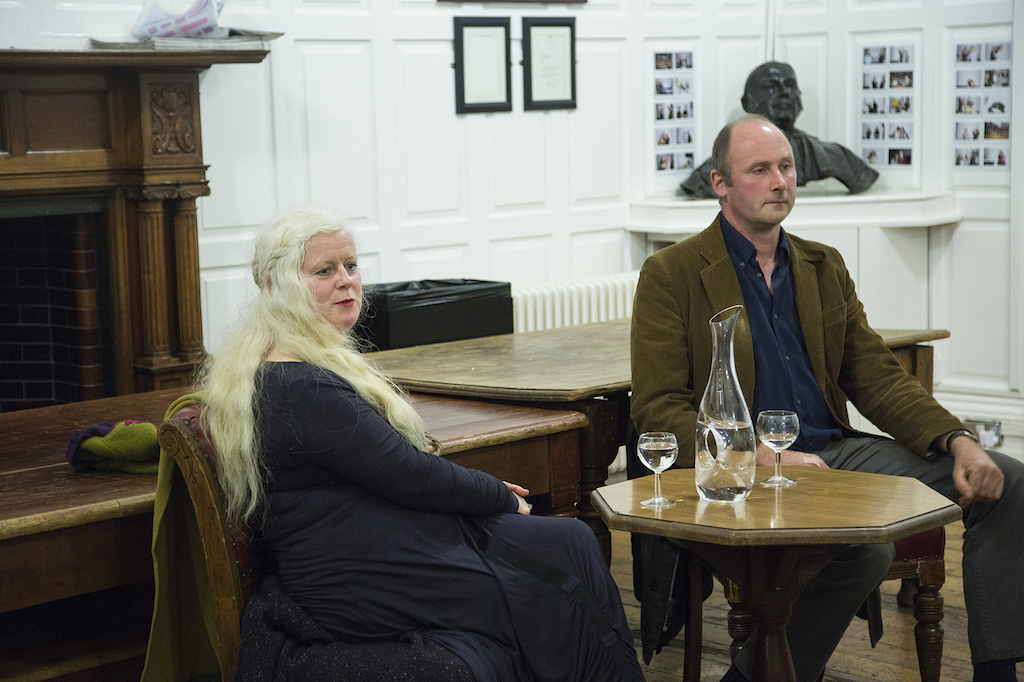
Despite the wet and windy weather last night, there was a healthy turnout at the Theological Society for an enlightening talk on modern Druidism. The event was held by Eimear Bone and Luke Eastwood from the Irish Druid Network. Bone is the high sorceress of her own circle in Kilkenny, and Eastwood a founding member of the network.
Eastwood began by telling us how he was born in Scotland with a mixed heritage of Irish, Scottish, English and German blood. During his childhood he experienced a “confused sense of identity” as his mother was an atheist and his father’s family devout Catholic. He first experienced Druidism at a wedding in Avebury, which holds the largest druid circle in Europe. He explained that whilst a huge “corpus of literature” on druidry exists, many people are oblivious, thus considering those who practice it to be “a bit nuts”. As there is no hierarchy or figurehead to the religion, it is a mainly self-explorative form of worship.
Bone described how even as a child Catholicism “did not resonate” with her. She trained as a nurse and travelled to Africa. The Christian traditions intertwined with her medical work made her feel uneasy, she said. She then studied psychology in Trinity. Whilst practicing as a psychologist, she found her professional training asked her to leave the spiritual issues of her clients to the clergy. For Bone, the turning point occurred one day on Grafton Street when she saw a book called “A Modern-day Druidess” by Cassandra Eason. After reading it, she decided to take a druidry course with The Order of Bards, Ovates and Druids (OBOD), and is still studying thirteen years later.
The Q&A session then began with the first question “What would be a typical ritual or ceremony, and what would it involve?” In response, Bone described how the rite would begin with an invocation of the gods and goddesses particular to that location, the rite itself would follow and then there would be a closing prayer and thanks. The ceremonies often take place outside, among trees and are performed in a circle. The most recent ceremony was Samhain (Halloween), where the ancestors join the circle while the veil between the world of the living and the dead is at its thinnest. Food is shared with them and people write down things they want to discard from their life and then burn the paper. In two weeks time it will be the winter solstice which for druids is a time of death and subsequent rebirth. Eastwood then described how he personally prefers to use a “skeleton structure” in his circles and leave the rest of the ceremony open to spiritual spontaneity.
According to Bone, there is a universal deity or “source” for which we all have different names. This deity can be invoked polytheistically through Druidism as Jesus, Allah, Mary etc. Eastwood and Bone were then asked: “What are the experiences like? How can you prove them?” Bone replied: “I can’t prove them. It’s about a lived experience. It’s not something I believe. It’s something I know.” Eastwood then used a bamboozling metaphor: “Look at this jug. I can see one side, you can see the front, Eimear can see the other side. None of us have the same angle on things”.
With regards to gender equality, Bone explained that there is no disparity in modern-day druidism despite being historically matriarchal. In fact, there is no hierarchy at all in Druidism. When asked about the key theology of their religion, they claimed their highest concern is synchronicity with nature and utilitarian stewardship of the earth. Eastwood described how we are connected to each other, animals and nature through a “web of life”. Since becoming a druid he says he could no longer live in London, simply because it is so oppressively urban. The session closed with a question on the existence of reincarnation. Bone answered “yes, there is a belief that we come back, hopefully as a more evolved being, in connection with a world of ancestors.”
Following the talk, I had the opportunity to interview them both. As Eastwood was a founding member of the Irish Druid Network, I asked him about the aims of the network for the future and for young people? He keenly responded: “It’s really quite simple. It’s just an information resource. It doesn’t have any sort of agenda in trying to promote Druidism in an evangelical way. It’s trying to facilitate people communicating and being able to get together … that’s why me and this other guy set it up. Our sole purpose is to provide information, and a lot of people, mainly younger people, might send an email and ask questions.”
My next question concerned the availability of druidism to young people in Ireland. Bone responded by urging people to come along to a ceremony and get a feel for it. Eastwood agreed and added “… and probably look at some kind of formal training. We’ve both done the OBOD training, there is a druidry college and if you’re lucky you can find an in-person teacher”.
Eager to find out more about the OBOD, I asked what it entailed. Bone described the process: “It meant taking a ‘distance course’ where every month I would get a wers – that’s the Welsh word for lesson. Traditionally, they say it takes a druid 19 years to train. No-one asks what level you’re at. Like no-one asks what’s in your bank account – it doesn’t matter – your path is your path!”






